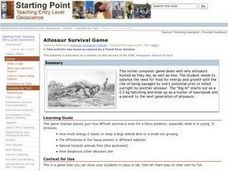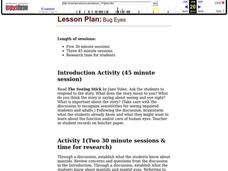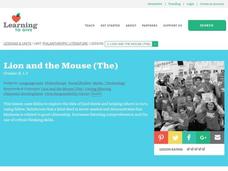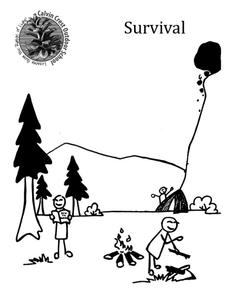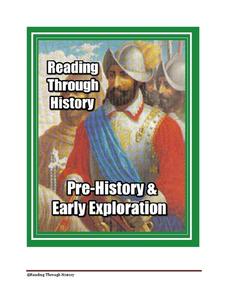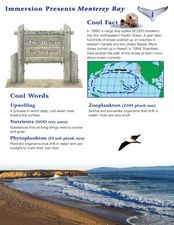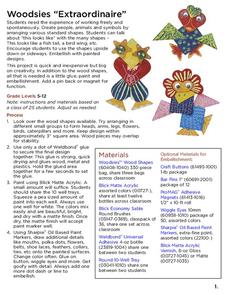Curated OER
Allosaur Survival Game
High schoolers uses this game to see how difficult survival is even for a fierce predator, especially when it is young. It stresses: How much energy it takes to keep a large animal alive or a small one growing, The differences in the...
Curated OER
Go, West, Pack Light!
Students investigate the hardships related to pioneer life and the Wagon Train. They listen to an excerpt from the book "Little House on the Prairie," and discuss the hardships faced by pioneers travelling west. In small groups...
Curated OER
Oh Deer! and English Learner Writing Extensions
Students follow deer through Yellowstone Park and record the number of deer from year to year. In this basic needs of deer lesson, students work in small groups and chart the number of deer each year and give explanations using as...
Curated OER
Bug Eyes
Students explore mantid eyes and human eyes. In this mantid eyes and human eyes research lesson, students work in small groups to gather information. Students read books, observe mantids, and do experiments. Students then present their...
Curated OER
African Elephants
In this elephant worksheet, students read several factual paragraphs about African elephants. Students then answer several questions about the animals.
Read Works
Trading Pumpkins
Can you imagine a pumpkin patch without pumpkins? Learners read how Tammy's family solves their problem in a cooperative way, followed by a set of 10 reading comprehension questions.
Space Awareness
Investigating the Atmosphere - Air Takes Up Space
How do you know there is air? Can you see it, smell it, feel it? To begin the investigation, learners watch a video and discuss what they know about air and the atmosphere. Then, they participate in five different hands-on, inquiry-based...
Curated OER
Animal Classification
Learners watch video and slide shows as an introduction to animals. They discuss classifications of animals while moving from most common to least common of the animals. Types of classifications includes herbivores/carnivores;...
Curated OER
The Lion and the Mouse
Students examine a story. For this good citizenship lesson, students read the story "The Lion and the Mouse" and discuss being kind and what it means to be a good citizen. Students hold a discussion about how other animal pairs could...
Curated OER
The Inside of an Apple
Young scholars review the life cycle of apples before they study information about the inside of apples. They work in small groups to color and identify the parts of the inside of an apple. Finally, they use real apples to have an hands...
American Museum of Natural History
A Closer Look at Mars
A website looks at how we know so much about Mars—telescopes, robots, and spacecraft—and the search for martian life. Following the informational text are three questions that quiz pupils about possible life on Mars.
Curated OER
Valentine's Kindness
Students learn about kindness. For this kindness lesson, students bring a stuffed animal from home and discuss times they have felt sad and what they have done to cheer up others. Students discuss why it is important to be kind. An...
Curated OER
Exploring Organisms
Students investigate various organisms in an attempt to understand the process of evolution and related ecological issues. This elementary activity uses small plastic animals and includes a worksheet for student assessment and reflection.
Curated OER
What am I?
In this animal related worksheet, students read and analyze each clue card to figure out what animal is being described and check their answers against the answer key.
Curated OER
March Answer Key
In this Easter worksheet, students read a letter to their parents. The 10 words in italics can also be removed in order to create a fill-in-the blank exercise.
Curated OER
Fearsome Creatures 1
In this wild animals worksheet, students fill in the blanks or choose the correct words to sentences about wild animals. Students complete 47 blanks.
Calvin Crest Outdoor School
Survival
Equip young campers with important survival knowledge with a set of engaging lessons. Teammates work together to complete three outdoor activities, which include building a shelter, starting a campfire, and finding directions in the...
American Museum of Natural History
What is Marine Biology?
A marine environment covers the majority of the earth but is arguably the least understood. Teach young scientists about the characteristics of oceans and ocean species using an interactive online lesson. The in-person or remote learning...
American Museum of Natural History
A Whale of a Tale
What's the most interesting fact about a blue whale? Learners read an interview about the similarities between the Titanosaur and the blue whale displays at the American Museum of Natural History. Pupils learn not only about blue whales...
ARKive
Adaptation: Design a Species
Adapt is what an animal does to ensure it will survive in a specific environment; maybe it's more complicated than that. Your young animal experts can view this handy presentation to better understand animal adaptations and also complete...
Reading Through History
Early History and Exploration Unit
We all know about Christopher Columbus, but who else explored the Americas, and specifically, the future United States of America? Learners find out these answers and more in a resource that includes four different reading sections,...
Mathematics Vision Project
Module 2: Systems of Equations and Inequalities
The brother-sister pair Carlos and Clarita need your class's help in developing their new pet sitting business. Through a variety of scenarios and concerns presented to the siblings, the learners thoroughly explore systems of equations...
Curated OER
Monterey Bay
Students read background information about Monterey Bay, California, and conduct related experiments. In this ocean in motion lesson plan, students read information about the location, wildlife, and characteristics of Monterey Bay. They...
Curated OER
Woodsies "Extraordinaire"
Allow your class to use their imaginations and create fun creatures with various wooden shapes and other embellishments. What a great way to encourage your young artists to stretch their minds!


